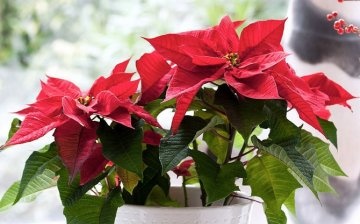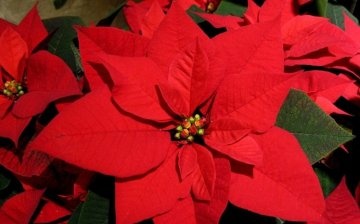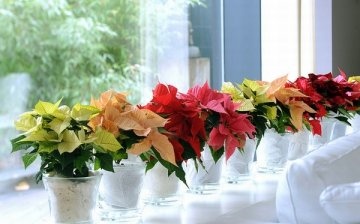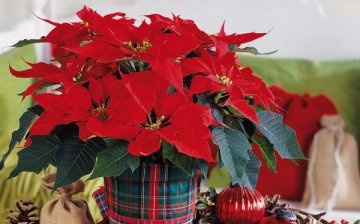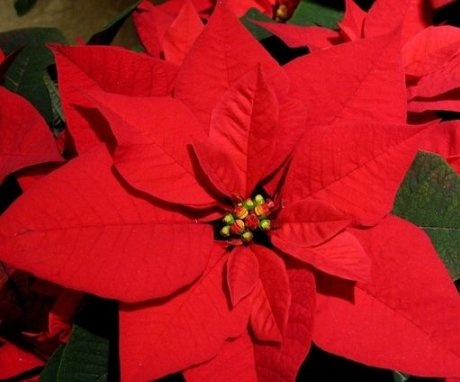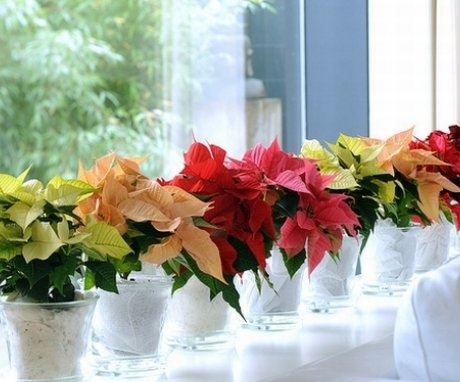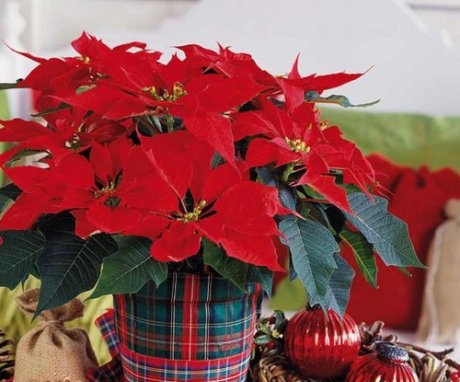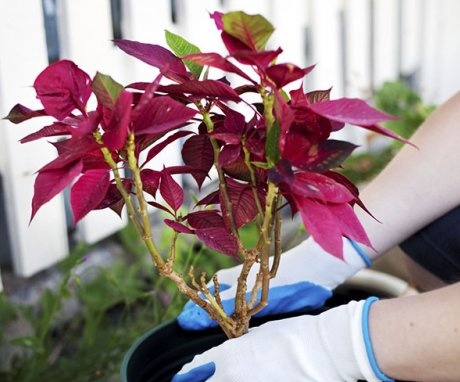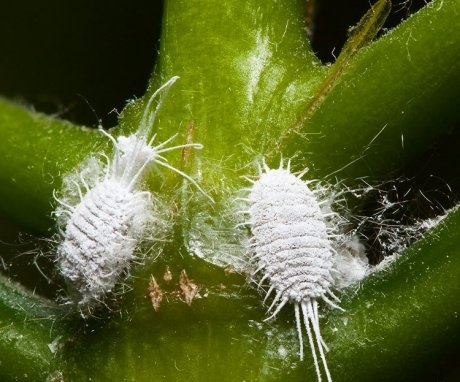Poinsettia: how to properly care for a flower?
A beautiful bright flower "Poinsettia" is a frequent gift for various festivities in December. But few people know how to handle it. Most, after flowering, put them in the far corner and no longer remember. But a beautiful shrub with special care can give joy for more than one year.
Content:
- Poinsettia: flower features
- Lighting, humidity and temperature
- Watering and feeding
- Transplant and pruning
- Diseases and pests
Poinsettia: flower features
Poinsettia is a beautiful flower from the Euphorbia genus; it is popularly called “Euphorbia” or “Christmas Star” due to its rich bright shade of inflorescence. His homeland is distant Central America and the rainforests of Mexico. In living nature, the shrub is a mighty thicket, which, depending on the growing conditions, can reach from 1.5 to 3-4 meters in height. In our country, this type of plant grows as an ornamental plant and does not exceed 30-40 cm, the maximum can reach up to 50 cm.
In winter, when there is no wide variety of flowers, interesting shrubs appear on the flower shelves. They draw attention to themselves with a rich dark green shade of the lower leaves, an elongated ellipse. They can also look like an egg, but the edges of the leaves will certainly be pointed.
Stipules are located on top of the greenery as bright stars. They most often attract the bulk of buyers. Many people believe that these are the original flowers, but they are not.
Real flowers are located in the core of stipules and are not of particular value, since they bloom inconspicuously, in a light yellow tone, with a small amount, in a bunch.
Flowering usually occurs in December.
The duration of dropping the buds, depending on the growing conditions, can vary from 2 to 4 months. But in a home stay, this is extremely, due to the high moodiness of the plant. After flowering small inflorescences, the shrub sheds bright upper plumage and freezes. Poinsettia during this period should rest, it throws off all the leaves and slows down its development. A similar moment occurs in February - March.
In the summer months, growth resumes, there is an active build-up of green mass. Closer to autumn, the bush begins to prepare for a riotous bloom. The red shade of the stipules is the natural color of the flower. But the careful work of breeders has led to a rich variety of colors - from milky, to orange and even blue and lilac tones. You should not immediately give up the flower after its flowering, having rested, it will again gain strength for a riot of colors.
Lighting, humidity and temperature
Poinsettia has an extremely capricious disposition, she is a wayward lady. She needs a certain temperature for optimal growth and development. It does not tolerate surges in the indoor thermometer. It should not be supercooled by sharp drafts. She tends to respond with rapid leaf fall and long-term illnesses.
If, by working hard and creating favorable conditions for lighting, humidity and temperature conditions for the beauty, then you can achieve long flowering and bright colors of stipules:
- You should not experiment and install a flowerpot with shrubs on the southern windowsill. For a tropical beauty, bright direct sunlight is destructive. She prefers diffused dim light. Otherwise, delicate leaves have the opportunity to become covered not only with burns, but also develop into completely dry leaves.
- When poinsettia blooms, on the contrary, it needs an abundance of sun. But in winter, unfortunately, there is not as much of it as needed. Therefore, you have to supplement the flower with the help phytolamp... If this is not done, then the upper bright leaves will lose all their beauty and uniqueness.
- Poinsettia reacts especially reverently to room temperature. She loves a cool stay at + 18 + 25 C. Without possible cool breezes of air or sudden jumps in heat. During the flowering period, a temperature of + 14 + 18 C is good for her, and during the dormant period, it should not exceed +14 C. It is these temperature preferences that have a beneficial effect on the development of a capricious flower.
- It should be noted that most often the purchase of this plant is carried out in winter. But few people think that having bought a flower, it is taken out into the cold air. And in December there is not always a positive temperature outside, which is detrimental to the shrub.
- The minimum temperature for transportation in the open air is +5 C. And also in the open form, a bright beauty should never be carried. It should be wrapped in paper, a bag, or covered with a soft cloth. Otherwise, do not be surprised at the rapid fall of the leaves and the death of the entire bush.
- The most favorable humidity for poinsettia is 60-70%. In winter, it actively responds to spraying, due to excessively dry air next to the battery. In addition, when irrigating from a spray bottle, you do not need to use a large stream or large spraying. The best option for moisturizing is small holes, from which a mist of the smallest specks of moisture erupts next to the flower.
Thus, the plant requires complex constant supervision. But after long and painstaking courtship, it shares with everyone the beauty of its plumage.
Watering and feeding
Watering tropical shrubs is carried out as needed. Naturally, in the summer months, the humidity increases slightly, and in the winter, on the contrary, decreases. A capricious lady loves good moisture, loose soil and a large abundance of oxygen.
But at the same time, do not pour it over or provoke moisture stagnation. If this happens, then there is a likelihood of root rot or the appearance of pathogenic bacteria. Therefore, it is recommended immediately after watering, wait until the soil is completely saturated and the excess water drains out. After that, it is more expedient to pour out unnecessary moisture from the pallet.
Water for irrigation should be taken at room temperature.
After the purchase, if the flower has not thrown off its leaves and also continues to delight with a violent color, it must be fed. The additive must be made complex for home flowering plants. Thanks to this stimulation, budding will continue for a long period of time.
The next top dressing is necessary only at the beginning of spring. It should be done once every 14 days. The period of permanent fertilization should end only at the end of autumn, just before the beginning of flowering. Therefore, you should carefully monitor so as not to overdry the beauty. At the same time, periodically fertilize for active growth and planting nutrients for abundant flowering.
Transplant and pruning
After the end of long flowering, the plant retires. Many uninformed gardeners unknowingly throw out pots with bare branches. This is absolutely not worth doing, the flower will rest, gain strength and rush into battle with a new zeal for beauty.
In order for the poinsettia to grow well, it must be properly trimmed.
It is not worth leaving very long shoots, they are useless.Waking up in the spring, young shoots will quickly fill in the missing gaps. Therefore, it is necessary to leave a few branches no more than 10-15 cm from the central trunk. This is quite enough for a new round of the life cycle. After removing excess growth, the flowerpot should be moved to a slightly shaded place, slightly lower the temperature to + 14 + 15 C and periodically watered.
Typically, the rest period ends in the middle or closer to the end of mid-spring (April). As soon as the first movements to revival are noticeable - timid green shoots, there is an opportunity for transplanting the shrub into a new substrate and a fresh flowerpot:
- You need to transplant by transshipment. It is good to moisten the earth beforehand, but so that it does not fall apart in the hands, but gets one lump of earth.
- Purchase or pick up a flowerpot a couple of centimeters larger in diameter than the previous place of residence.
- Mandatory drainage is placed in a new container at the bottom, and then an earthen lump transferred from the old flowerpot is placed.
- A special substrate for flowering plants purchased in a store is poured into the resulting space. It is already equipped mineral fertilizers, therefore, has a beneficial effect on the growth of young leaves.
If you wish, you can prepare the optimal potting mix yourself. To do this, it is necessary to take in equal parts humus, peat, sand and sod, as well as leafy soil. But at the same time, make sure that the combined substrate has the proper acidity.
Diseases and pests
Like any indoor flower, poinsettia tends to be exposed to various diseases and pests. The most common pests:
- Mealybug.
- Shield.
- Spider mite.
- Whitefly.
- Thrips.
At the moments of an attack by intruders, a whitish sticky coating or a spot of the same color is formed on the leaves and trunk. These blotches feel like wax drops. In the fight against annoying pests, a solution of soap solution mixed with ash... If you don't want to mess around with the preparations, there is an opportunity to purchase chemical insecticides to eliminate pests. In the event of a worm infestation, mineral oil quickly helps to cope with the problem.
In addition to intrusive insects, a flower can become infected with a disease:
- Fusarium - provokes almost complete death of shoots on the flower.
- Gray rot - provoked by abundant watering and high humidity. Its formation is evidenced by gray spots with possible fluff on the leaves or stems of the evergreen beauty. It can be treated under the influence of "Fundazol", "Skor" or "Celandine".
- Powdery mildew - a bloom of white color appears on the greenery and stem. In a short time, it completely captures the entire territory of greenery and contributes to the death of all shrubs. "Fitosporin-M" and "Topaz».
- Yellowness of the leaves - provoked due to abundant moisture and a decrease in temperature, which contributes to decay of the root system and death.
The basic rule in the care of poinsettia is constant monitoring of the leaves and stems. At the first appearance of pests or an emerging disease, it is advisable to take drastic measures. Thus, the evergreen shrub is not only a beautiful flower, but also a rather capricious and demanding plant. You should know all the subtle places in order to avoid death and promote long flowering and good development.
More information can be found in the video:



